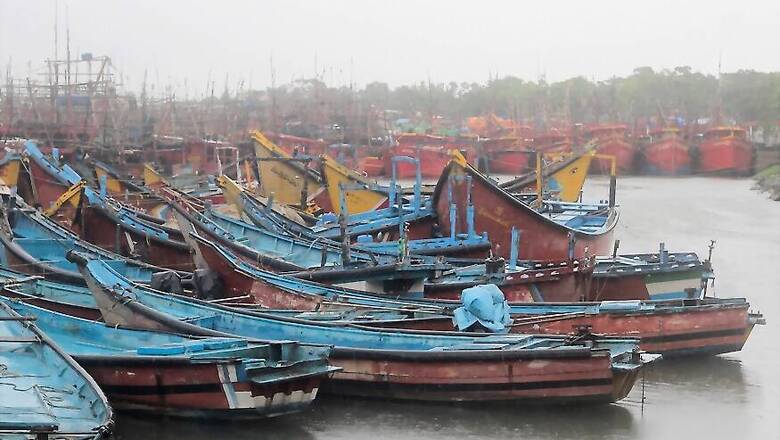
views
Cyclone Amphan, the year’s first tropical cyclone to form in the Bay of Bengal, slammed into the delta region between Digha in West Bengal and Bangladesh on Wednesday afternoon with wind speeds touching 165 kmph. The tropical cyclone became the first, since the devastating cyclone of 1999 that hit Odisha, to morph into a super cyclone as wind speeds crossed 220 kmph. The cyclone, however, made landfall as an ‘extremely severe cyclonic storm’, a tad less powerful than a super cyclone.
Even as Amphan (pronounced UM-PUN) is perhaps not the last cyclone to form over the Bay this year, its rapid intensification is a grim reminder of the dangers posed by a warming Indian Ocean, scientists said.
The sea surface temperatures (SST) are usually warmer over the Bay of Bengal as compared to the Arabian Sea. This summer, prior to the formation of Amphan, temperature over the Bay of Bengal ranged between 31-34 degree Celsius, which was above the normal levels. Scientists from the India Meteorological Department (IMD) and Indian Institute of Tropical Meteorology (IITM) said that anything above 27 degree Celsius quickens the formation of a cyclone after a low-pressure area develops.
The Indian government has been monitoring sea surface temperatures with the help of buoys and argo floats that are placed in the Indian Ocean. This initiative began from 2000 onward and the data is monitored by the Indian National Centre for Ocean Information Services (INCOIS).
Dr Roxy Mathew Koll, scientist at Indian Institute of Tropical Meteorology, said, “Some of the buoys in Bay of Bengal registered maximum temperatures of 32-34 degree Celsius in the first two weeks of May. These are record temperatures driven by climate change – we have never seen such high values until now. These high temperatures can super charge a cyclone since tropical cyclones primarily draw their energy from evaporation at the ocean surface.”
“Prior to cyclone Amphan’s formation, the sea surface temperature seems to have increased aided by clear and calm skies,” he added.
Amphan intensified from a Category-I cyclone to a Category-5 cyclone in less than 24 hours, thus generating higher wind speed in a short duration. Rapid intensification of a storm occurs if maximum sustained wind speed increases by 55 kmph in 24 hours duration. In the case of cyclone Amphan, it intensified at twice that rate between May 16 and May 17, and its intensity rose by 70 kmph, according to CIMSS (Cooperative Institute for Meteorological Satellite Studies).
The dangers of more powerful cyclones in the Bay of Bengal are amplified as it threatens large-scale devastation due to storm surges in the densely populated delta regions of West Bengal and Bangladesh. Storm surges lead to tidal waves that are as tall as 20 feet, that not only destroy everything in its path but also ruin livelihoods based on farming. The ingress of saline water also has a long-term impact on the region’s groundwater.
The formation of Cyclone Amphan led to the evacuation of nearly 1 million people from Odisha and West Bengal from low-lying and vulnerable coastal areas. A 2019 study published in Nature, estimated that by 2050 around 36 million people in India and 42 million people in Bangladesh are at risk due to rise in sea-levels and annual storm surges.
“The heat content of ocean is like fuel for tropical cyclones. When the sea surface temperature rises, it is highly conducive for the formation of cyclones. Ocean warming has been observed globally and more so in the Indian Ocean,” said M Rajeevan Nair, Secretary, Ministry of Earth Sciences told News18.com.
The reduction in carbon emissions across the globe also seems to have played a hand in additional warming of the sea. “This lockdown has significantly reduced human emissions into the atmosphere. This decrease means that surface warming due to the removal of human-made aerosols has increased and atmospheric warming (due to those absorbing aerosols such as Black Carbon) has decreased significantly during this time. This surface warming extends over the waters in the Bay of Bengal,” said Dr V Vinoj, Assistant Professor, School of Earth, Ocean and Climate Sciences, Indian Institute of Technology, Bhubaneswar.
“Therefore, the global warming effect which tends to increase the strength of cyclones, if any, is now amplified due to this human induced lockdown effect. This may be the reason why Amphan strengthened into a super cyclone, a second one only to the 1999 super cyclone.” Vinoj added.


















Comments
0 comment